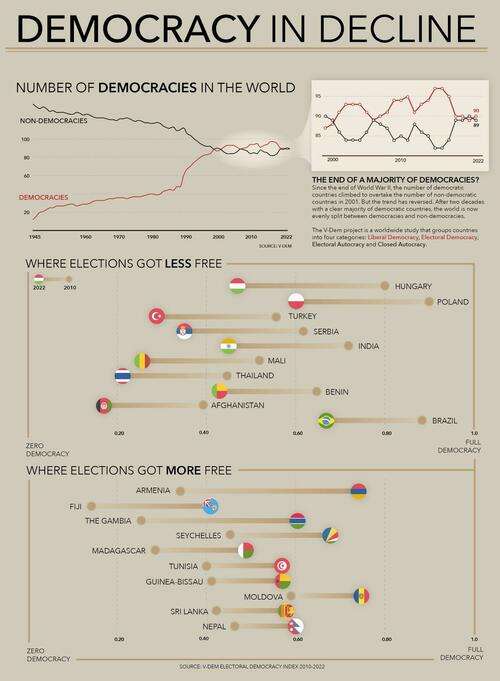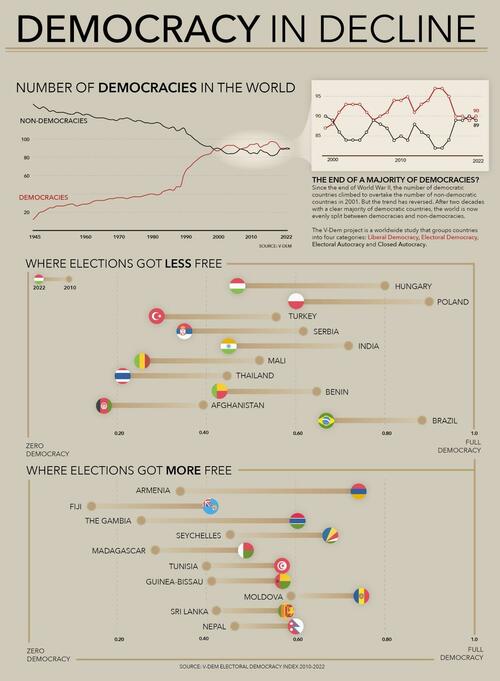The end of World War II in 1945 was a turning point for democracies around the world.
Before this critical turning point in geopolitics, democracies made up only a small number of the world’s countries, both legally and in practice. However, over the course of the next six decades, the number of democratic nations would more than quadruple.
Interestingly, as Visual Capitalist’s Freny Fernandes details below, studies have found that this trend has recently reversed as of the 2010s, with democracies and non-democracies now in a deadlock.
In this visualization, Staffan Landin uses data from V-DEM’s Electoral Democratic Index (EDI) to highlight the changing face of global politics over the past two decades and the nations that contributed the most to this change.
The Methodology
V-DEM’s EDI attempts to measure democratic development in a comprehensive way, through the contributions of 3,700 experts from countries around the world.
Instead of relying on each nation’s legally recognized system of government, the EDI analyzes the level of electoral democracy in countries on a range of indicators, including:
- Free and fair elections
- Rule of law
- Alternative sources of information and association
- Freedom of expression
Countries are assigned a score on a scale from 0 to 1, with higher scores indicating a higher level of democracy. Each is also categorized into four types of functional government, from liberal and electoral democracies to electoral and closed autocracies.
Which Countries Have Declined the Most?
The EDI found that numerous countries around the world saw declines in democracy over the past two decades. Here are the 10 countries that saw the steepest decline in EDI score since 2010:
| Country | Democracy Index (2010) | Democracy Index (2022) | Points Lost |
|---|---|---|---|
| 🇭🇺 Hungary | 0.80 | 0.46 | -34 |
| 🇵🇱 Poland | 0.89 | 0.59 | -30 |
| 🇷🇸 Serbia | 0.61 | 0.34 | -27 |
| 🇹🇷 Turkey | 0.55 | 0.28 | -27 |
| 🇮🇳 India | 0.71 | 0.44 | -27 |
| 🇲🇱 Mali | 0.51 | 0.25 | -26 |
| 🇹🇭 Thailand | 0.44 | 0.20 | -24 |
| 🇦🇫 Afghanistan | 0.38 | 0.16 | -22 |
| 🇧🇷 Brazil | 0.88 | 0.66 | -22 |
| 🇧🇯 Benin | 0.64 | 0.42 | -22 |
Central and Eastern Europe was home to three of the countries seeing the largest declines in democracy. Hungary, Poland, and Serbia lead the table, with Hungary and Serbia in particular dropping below scores of 0.5.
Some of the world’s largest countries by population also decreased significantly, including India and Brazil. Across most of the top 10, the “freedom of expression” indicator was hit particularly hard, with notable increases in media censorship to be found in Afghanistan and Brazil.
Countries Becoming More Democratic
Here are the 10 countries that saw the largest increase in EDI score since 2010:
| Country | Democracy Index (2010) | Democracy Index (2022) | Points Gained |
|---|---|---|---|
| 🇦🇲 Armenia | 0.34 | 0.74 | +40 |
| 🇫🇯 Fiji | 0.14 | 0.40 | +26 |
| 🇬🇲 The Gambia | 0.25 | 0.50 | +25 |
| 🇸🇨 Seychelles | 0.45 | 0.67 | +22 |
| 🇲🇬 Madagascar | 0.28 | 0.48 | +20 |
| 🇹🇳 Tunisia | 0.40 | 0.56 | +16 |
| 🇱🇰 Sri Lanka | 0.42 | 0.57 | +15 |
| 🇬🇼 Guinea-Bissau | 0.41 | 0.56 | +15 |
| 🇲🇩 Moldova | 0.59 | 0.74 | +15 |
| 🇳🇵 Nepal | 0.46 | 0.59 | +13 |
Armenia, Fiji, and Seychelles saw significant improvement in the autonomy of their electoral management bodies in the last 10 years. Partially as a result, both Armenia and Seychelles have seen their scores rise above 0.5.
The Gambia also saw great improvement across many election indicators, including the quality of voter registries, vote buying, and election violence. It was one of five African countries to make the top 10 most improved democracies.
With the total number of democracies and non-democracies almost tied over the past four years, it is hard to predict the political atmosphere in the future.








